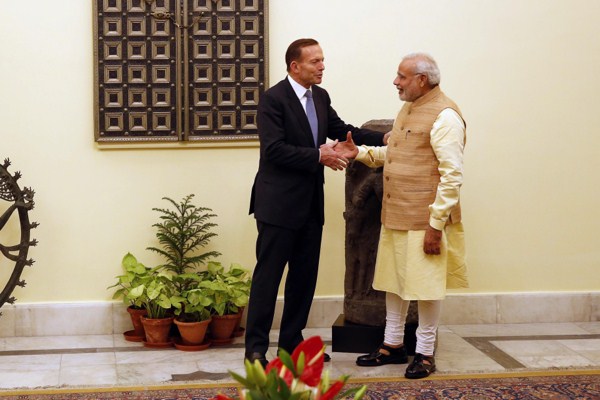Australian Prime Minister Tony Abbott’s visit to India last week highlighted the two countries’ increasingly complementary geoeconomic objectives. The visit saw the conclusion of a much-delayed bilateral civil nuclear cooperation agreement that paves the way for uranium exports from Australia’s high-quality mines to fuel India’s ambitious nuclear energy plans. While in value terms future Australian uranium exports may not seem like much, they will actually enable India to undertake its next wave of industrialization in a more carbon-competitive manner, and that in turn will fuel massive demand for other Australian mineral exports. The strategic nature of the India-Australia alignment is likely to be rounded up with a maritime cooperation agreement in the near future aimed at securing much of the eastern Indian Ocean for a vastly expanded resource flow of both migrants and materiel.
The bilateral civil nuclear deal signed during the visit was the first such agreement concluded by Australia with a country outside the non-proliferation treaty (NPT) framework, marking a hard-won consensus within Australia’s policymaking circles to engage with India with a clear eye on the future. Moreover, that a country such as Australia, which has had a consistent uranium export policy since 1977, is on board with India’s civil-military separation plan and safeguards arrangements with the IAEA serves to further boost India’s reputation as a country with a strong nonproliferation record and natural standing in a new rules-based global framework for strategic trade. Prior to Abbott’s visit, India’s new government led by Prime Minister Narendra Modi also ratified an additional protocol with the IAEA, something that Australia requires from counterparties before it supplies uranium.
The joint statement issued on the sidelines of the visit explicitly states that the two sides “agreed to develop a strategic partnership on energy and resources based on long-term, sustainable and reliable supply of Australian resources based on India's energy needs.” The word “reliable” is quite important, since that is precisely what India has been looking for to increase its nuclear generation capacity to 63 GWe by 2032. Domestic support for the India-U.S. civil nuclear agreement, which ultimately laid the groundwork for the India-Australia agreement, was in large part driven by India’s need for a reliable overseas supplier of natural uranium. India’s domestic uranium reserves are modest and mostly comprised of low ore grades, making extraction both expensive and difficult. On the other hand, Australia boasts about 31 percent of the world’s uranium reserves.

